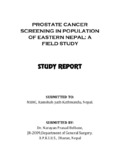Please use this identifier to cite or link to this item:
https://hdl.handle.net/20.500.14356/809Full metadata record
| DC Field | Value | Language |
|---|---|---|
| dc.contributor.author | Belbase , Dr. Narayan Prasad | |
| dc.date.accessioned | 2012-12-29T05:10:46Z | |
| dc.date.accessioned | 2022-11-08T10:21:10Z | - |
| dc.date.available | 2012-12-29T05:10:46Z | |
| dc.date.available | 2022-11-08T10:21:10Z | - |
| dc.date.issued | 2010-09 | |
| dc.identifier.uri | http://103.69.126.140:8080/handle/20.500.14356/809 | - |
| dc.description.abstract | Prostate cancer is the second most frequently diagnosed cancer and the sixth leading cause of cancer death in males, accounting for 14% (903,500) of the total new cancer cases and 6% (258,400) of the total cancer deaths in males in 2008 (Jemal et al, 2011). Descriptive epidemiology has shown wide ethnic/racial differences in the incidence of Prostate carcinoma. The highest incidence rate group (100/100,000/year) includes African Americans in the United States; intermediate rates (20–50/100,000/year) are observed in Canada, South America, and European countries; and lowest rates (10/100,000/year) in Japan, China, and India (Watanbe et al, 2000). Temporal trends in incidence rates in countries with higher uptake of PSA testing such as the United States, Australia, Canada, and the Nordic countries followed similar patterns (Jemal et al, 2011). Prostate cancer has a highly variable natural history, ranging from an indolent and silent entity throughout a man’s entire life to one that grows rapidly, metastasizing to lymph nodes and bone, with a median life expectancy of 24 to 36 months after bony metastases are detected. It is largely asymptomatic until metastases are present. The medical community has advocated early detection and treatment of prostate cancer for nearly a century. As early as 1905, the noted urologist Hugh H. Young, concluded that careful digital rectal examination (DRE) could identify prostatic changes that herald the first signs of cancer. For the next 75 years, this was the only screening test available, but an imperfect one (Brawley et al, 2009. In the early 1980s, clinicians reacted with optimism to initial studies using a blood protein, prostate–specific antigen (PSA), as a screening test for this disease because of an increasing death rate and the poor performance of the DRE (Catalona et al, 1991). | en_US |
| dc.language.iso | en_US | en_US |
| dc.subject | Prostate Cancer | en_US |
| dc.subject | Eastern Nepal | en_US |
| dc.title | Prostate Cancer Screening in Population of Eastern Nepal: A Field Study | en_US |
| dc.type | Technical Report | en_US |
| Appears in Collections: | Post Graduate Grant (PG) Reports | |
Items in DSpace are protected by copyright, with all rights reserved, unless otherwise indicated.

